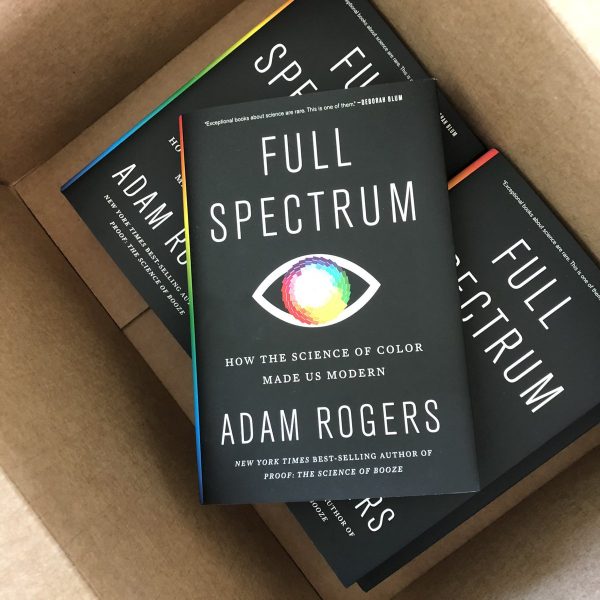In 2015 the world was divided into two warring factions overnight. And at the center of this schism was a single photograph. Cecilia Bleasdale took a picture of a dress that she planned to wear to her daughter’s wedding and that photo went beyond viral. Some saw it as blue with black trim; others as white with gold trim. For his part, Wired science writer Adam Rogers knew there was more to the story — a reason different people looking at the same object could come to such radically divergent conclusions about something as simple as color.

Rogers recently wrote a book titled Full Spectrum: How the Science of Color Made Us Modern. In this episode, Roman Mars talks with the author about how the pursuit to organize, understand, and create colors has been one of the driving forces shaping human history, starting with the story of this hotly debated piece of apparel from 2015 then winding back through built environments of global World’s Fairs.
From “kelly green” to “millennial pink,” our world is graced with a richness of colors. But our human-made colors haven’t always matched nature’s kaleidoscopic array. To reach those brightest heights required millennia of remarkable innovation and a fascinating exchange of ideas between science and craft that’s allowed for the most luminous manifestations of our built and adorned world.
In Full Spectrum, Rogers takes us on that globe-trotting journey, tracing an arc from the earliest humans to our digitized, synthesized present and future. We meet our ancestors mashing charcoal in caves, Silk Road merchants competing for the best ceramics, and textile artists cracking the centuries-old mystery of how colors mix, before shooting to the modern era for high-stakes corporate espionage and the digital revolution that’s rewriting the rules of color forever.



Comments (8)
Share
Can this be related to a person’s age? When we watched black and white TV, we had to imagine color based on the tones of the clothing worn. (I grew up in the 50’s). It was magical when some of the black and white shows/movies were colorized in later years. Were those the colors I imagined them to be? I don’t remember, but it was impossible to watch TV for me and not imagine everything in those shows as specific colors, and my own making.
Age matters for sure. Check this one out:
https://www.livescience.com/63645-optical-illusion-young-old-woman.html
It is important to note here that it is not true that the color sticks for everyone. I have seen both colors and I have even seen it switch as I was looking at it. Looking at the image from different angles seems to help push your mind to try and see the other color.
Absolutely love the story otherwise. The dress was one of those popular moments that I found so fun and interesting. Many people found it annoying but I am really glad to hear you both be so excited about something that was so…weird! It’s a really unusual image!
Thanks for the episode.
I heard also a good episode of “You are not so smart” about this explanation of this phenomenon: https://youarenotsosmart.com/2020/03/09/yanss-175-how-a-divisive-photograph-of-a-perceptually-ambiguous-dress-lead-one-scientist-to-build-the-nuclear-bomb-of-cognitive-science-out-of-socks-and-crocs-part-one/
I loved this episode because I was deeply fascinated but the question of why people saw different colors in that photo of the dress.
However, I was frustrated that right at the point where there was acknowledgement that a bumblebee might see different colors than we do (“which is right, which is wrong?”) we didn’t get an answer.
I believe there should be an answer.
Because in every photo, certain colors are present and certain colors are not. In the photo of the dress, when you zoom in using a tool like photoshop we can see, objectively, what colors are present. And they veer toward the beigy-brown rather than blue (regardless of what the actual color of the dress was in real life).
What I’d like to know is why some people can focus on the colors that are present in the photo for their assessment (white and gold) while others layer on an additional set of data (like what they believe the colors should be) to arrive at a different interpretation.
In other words, if you could keep all of the colors present in the photo, but alter the subject (the dress) to resemble no specifically recognizable object, would people still see different colors, or would there be greater agreement?
There’s an optical illusion that takes advantage of your brain’s ability to “correct” colours: https://en.m.wikipedia.org/wiki/Checker_shadow_illusion
The part that blows me away is that most people can’t turn this feature off. Go ahead and *try* to match up the two squares!
Also colour is relative- placing colours next to each other can change how we see them. The artist Josef Albers has very interesting examples of how this works.
And the book: ‘The Devil in the White City’ is fascinating- recommended for all 99% Invisibile listeners
One thing that preoccupies practicing scientists like myself is spectroscopy. I’m a biomedical engineer, and I think about the color spectrum on a nearly daily basis. It can range from absorbance, transmission, scattering, Beer-Lambert Law, fluorescence, how photons are absorbed in photocrosslinking reactions, how viscosity affects signal from a fluorescent dye (useful for studying viscosity changes in solutions). This episode was an absolute treat. I ordered the book because of it.